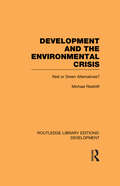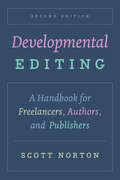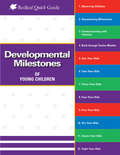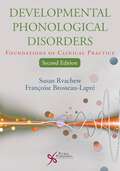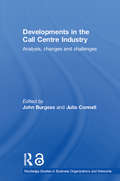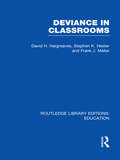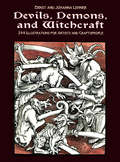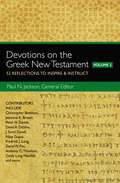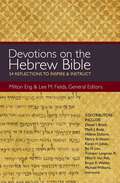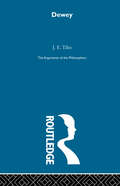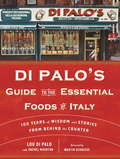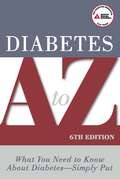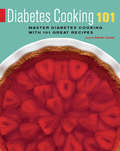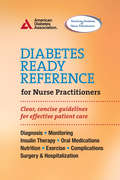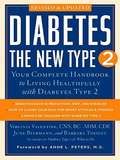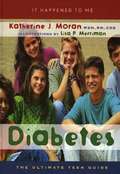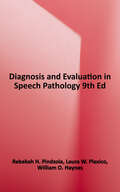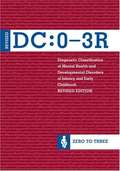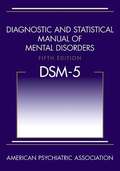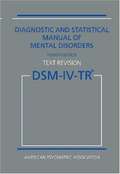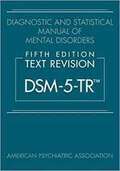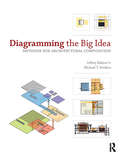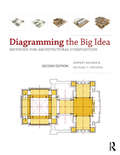- Table View
- List View
Development and the Environmental Crisis: Red or Green Alternatives (Routledge Library Editions: Development)
by Michael RedcliftFirst published in 1984, Michael Redclift’s book makes the global environmental crisis a central concern of political economy and its structural causes a central concern of environmentalism. Michael Redclift argues that a close analysis of the environmental crisis in the South reveals the importance of the share of resources obtained by different social groups. The development strategies based on the experiences and interests of Western capitalist countries fail to recognise that environmental degradation in the South is a product of inequalities in both global and local economic relations and cannot be solved simply by applying solutions borrowed from environmentalism in the North. The key to understanding the South’s environmental problems lies in the recognition that structural processes – markets, technology, state intervention – are also a determining influence upon the way natural resources are used. Through his review of Europe’s Green Movement, contemporary breakthroughs in biotechnology and information systems and recent feminist discourse, Michael Redclift has enlarged the compass of the environmental debate and produced a book which should serve as a benchmark in future discussions of development and the environment. It will be of importance to students in a range of disciplines, within development studies, geography, ecology and the social sciences.
Development of the Constitutions in China and the Visegrad States: A Comparative Perspective
by Lu DaThis book deals with the development of constitutional law in China and Visegrad states by employing a comparative perspective. It is the first time that the researcher compared the constitutional development in the China and the Visegrad states. It offers a few glimpses of development of constitution in the (former) socialist states to readers who are interested in the constitutional law or China–V4 relations. With the increased cooperation between China and V4 countries, this book gives the undergraduates in the university to think about the BRI and 17+1 network from a Chinese perspective. Last, compared to the previous works which mainly focus on North America and/or Western Europe, this book provides a new angle on comparative constitutional law.
Developmental Editing, Second Edition: A Handbook for Freelancers, Authors, and Publishers (Chicago Guides to Writing, Editing, and Publishing)
by Scott NortonThe only guide dedicated solely to developmental editing, now revised and updated with new exercises and a chapter on fiction. Developmental editing—transforming a manuscript into a book that edifies, inspires, and sells—is a special skill, and Scott Norton is one of the best at it. With more than three decades of experience in the field, Norton offers his expert advice on how to approach the task of diagnosing and fixing structural problems with book manuscripts in consultation with authors and publishers. He illustrates these principles through a series of detailed case studies featuring before-and-after tables of contents, samples of edited text, and other materials to make an otherwise invisible process tangible. This revised edition for the first time includes exercises that allow readers to edit sample materials and compare their work with that of an experienced professional as well as a new chapter on the unique challenges of editing fiction. In addition, it features expanded coverage of freelance business arrangements, self-published authors, e-books, content marketing, and more. Whether you are an aspiring or experienced developmental editor or an author who works alongside one, you will benefit from Norton’s accessible, collaborative, and realistic approach and guidance. This handbook offers the concrete and essential tools it takes to help books to find their voice and their audience.
Developmental Milestones of Young Children
by Karen PettyDevelopmental milestones mark the significant progress children make throughout their early years. This Redleaf Quick Guide includes descriptions of the typical physical, social, emotional, language, and cognitive milestones that infants, toddlers, preschoolers, and early elementary-age children reach. It also includes strategies for observing, recording, and communicating milestones to families.
Developmental Phonological Disorders: Foundations Of Clinical Practice
by Susan Rvachew Françoise Brosseau-LapréThe only graduate-level textbook designed for a competency-based approach to teaching, learning, and assessment. The book provides a deep review of the knowledge base necessary for the competent assessment, diagnosis, and treatment of developmental phonological disorders. Thoroughly revised and updated, the textbook contains learning objectives in each chapter to further support understanding of concepts and carefully designed case studies and demonstrations to promote application to clinical problem solving.<p><p> Key Features: <p><p> Learning objectives for each chapter subsection Includes the "how, why, and when" to apply each assessment and treatment procedure in clinical practice<p><p> 62 tables containing clinically relevant information such as normative data to interpret phonological assessment results<p><p> 99 figures to support clinical decision making such as recommending a treatment delivery model, selecting treatment targets, or choosing evidence-based interventions<p><p> 35 case studies to support a competency-based approach to teaching and assessment<p><p> 35 demonstrations that show how to implement assessment and treatment procedures<p><p> The second edition provides a comprehensive overview of seminal studies and leading-edge research on both phonological development and phonological disorders, including motor speech disorders and emergent literacy. This wealth of theoretical background is integrated with detailed descriptions and demonstrations of clinical practice, allowing the speech-language pathologist to design interventions that are adapted to the unique needs of each child while being consistent with the best research evidence.
Developments in the Call Centre Industry: Analysis, Changes and Challenges (Routledge Studies in Business Organizations and Networks #Vol. 39)
by Julia Connell John BurgessOver the past ten years there has been a massive growth in call centres worldwide. These centres are said to represent the most dynamic growth area in white-collar employment internationally since the mid 1990s. Yet the footloose and global nature of the industry means that jobs will always be susceptible to outsourced operations, ICT developments, public sector subsidization of business restructuring and re-location, and cheaper operations elsewhere. This book conducts a thorough analysis of this modern phenomenon.
Deviance in Classrooms (Routledge Library Editions: Education)
by Stephen Hester David H Hargreaves Frank J MellorWhen originally published this book reported the first major application of ‘labelling theory’ to deviance in classrooms. The authors explore the nature of classroom rules, show how they constitute a pervasive feature of the classroom, and examine the ways in which teachers use these rules as grounds for imputing ‘deviance’ to pupils. A theory of social typing is developed to show how teachers come to define certain pupils as deviant persons such as ‘troublemakers’ and several case-studies are used to document this analysis. Finally, the teachers’ reactions to disruptive classroom conduct are examined as complex strategic attempts at social control in the classroom. The book has a double focus on deviance theory and the process of teaching.
Devils, Demons, and Witchcraft: 244 Illustrations for Artists
by Ernst Lehner"Throughout history, artists have grappled with the problem of depicting clearly and forcefully the principles of evil and suffering in human existence." With this view, the Lehners have collected 244 representations, symbols, and manuscript pages of devils and death from Egyptian times to 1931. Reproductions from Dürer, Holbein, Cranach, Rembrandt, and many other lesser-known or unknown artists illustrate the fascinating history. The fifteenth, sixteenth, and seventeenth centuries are stressed.The book is divided into 12 chapters, each with a separate introduction. Most of the illustrations are collected in five of these chapters: Devils and Demons, including Belial, Beelzebub, and the Anti-Christ; Witches and Warlocks, their animals, forms, and rituals; The Danse Macabre, with the Dance of Death Alphabet by Holbein and representations of all classes leveled by the common force of death; Memento Mori, including a skull clock, a macabre representation of the Tree of Knowledge and Death, and the winged hourglass and scythe; and Religio-Political Devilry, the fight between the Papists and the Reformers, and symbols of devils in other political disputes. There are also chapters on the Fall of Lucifer, Faust and Mephistopheles, Hell and Damnation, The Apocalyptic Horsemen, Witch-Hunting, The Art of Dying, and Resurrection and Reckoning.Anyone curious about witchcraft, death, and devils will be interested in this book. It is particularly useful to teachers, artists, and illustrators who need clear reproductions for the classroom, for models, or for commercial uses. Death, devils, and their history are very much with us today.
Devotions on the Greek New Testament, Volume Two: 52 Reflections to Inspire and Instruct
by Paul Norman JacksonDevotions on the Greek New Testament, Volume Two contains an entirely new set of 52 devotions written by over 25 of today's best biblical language scholars. Contributors include Christopher Beetham, Jeannine K. Brown, Peter H. Davids, David A. DeSilva, J. Scott Duvall, Nijay Gupta, Frederick J. Long, David W. Pao, Anthony C. Thiselton, Cindy Long Westfall, and many more.The main point of each devotion in Devotions on the Greek New Testament, Volume Two comes from a careful reading of the passage in the Greek New Testament, not from an English translation. The authors use a variety of exegetical approaches in their devotions - including grammatical, lexical, rhetorical, sociohistorical, and linguistic - and each devotion closes with a practical application or spiritual reflection.Devotions on the Greek New Testament, Volume Two contains a devotion on every book in the New Testament and can be used as a weekly devotional or as a supplemental resource throughout a semester or sequence of courses. These devotions will inspire you to keep reading and meditating on the Scriptures and find new treasures from the biblical text.X
Devotions on the Greek New Testament: 52 Reflections to Inspire and Instruct
by J. Scott Duvall Verlyn VerbruggeZondervan is known for its excellent resources in biblical languages, and many of our resources encourage professors, students, and pastors to continue to use their Hebrew and Greek Bibles beyond their seminary years.Devotions on the Greek New Testamentcontinues on this path of excellence by introducing these devotions—based on a careful reading and study of the Greek New Testament—written by some of the top Greek scholars of today. Contributors include Scot McKnight, Daniel B. Wallace, Craig L. Blomberg, Mark Strauss, and William D. Mounce, among others.Devotions on the Greek New Testament can be used as weekly devotional or as a supplemental resource throughout a semester or sequence of courses. The main point each devotion offers comes from a careful reading of the passage in the Greek New Testament, not from the English Bible. These authors use a variety of exegetical approaches in their devotions: grammatical, lexical, rhetorical, sociohistorical, linguistic, etc. Each devotion closes with a practical application.
Devotions on the Hebrew Bible: 54 Reflections to Inspire and Instruct
by ZondervanThe main point of each devotion in Devotions on the Hebrew Bible comes from a careful reading of the passage in the Hebrew Bible, not from an English translation—written by some of the top biblical language scholars of today. Contributors include Daniel I. Block, Mark J. Boda, Hélène Dallaire, Nancy Erickson, Karen H. Jobes, Bo H. Lim, Tremper Longman III, Miles V. Van Pelt, Bruce K. Waltke, and Michael Williams, among others. The authors use a variety of exegetical approaches in their devotions—including grammatical, lexical, rhetorical, sociohistorical, and linguistic—and each devotion closes with a practical application or spiritual reflection.Miles Van Pelt, for example, shows that a careful analysis of a grammatical particle in Judges 3:9 elucidates the agent of Israel’s deliverance. Indeed, it is Yahweh who saves! Tremper Longman III explains the role of poetical parallelism in Psalm 1 and highlights how clearly the psalmist invites the reader to introspection, compelling the reader to follow the path of righteousness. And Bo Lim reminds the reader of the biblical precedent for expressing lament. He highlights the poetic artistry of the book of Lamentations, noting its beautiful acrostic, and confirms that both grief and hope provide the rhythm of faith and worship.Devotions on the Hebrew Bible contains a devotion on every book in the Old Testament and can be used as a weekly devotional or as a supplemental resource throughout a semester or sequence of courses. These devotions will inspire you to keep reading and meditating on the Hebrew Scriptures and find new treasures from the biblical text.
Dewey-Arg Philosophers (Arguments Of The Philosophers Ser.)
by J.E. TilesFirst Published in 1999. Routledge is an imprint of Taylor & Francis, an informa company.
Di Palo's Guide to the Essential Foods of Italy
by Martin Scorsese Jason Epstein Rachel Wharton Lou Di PaloThe ultimate guide to the finest foods of Italy from the oldest, most celebrated Italian market in New York City In the heart of New York City's Little Italy sits Di Palo's, a family-owned food shop that has been the treasure of the neighborhood for more than a century. The four generations of Di Palos who have run this Italian specialty market have made it their mission to bring customers the finest old-world selections from Italy--handcrafted mozzarella, buttery prosciutto, estate olive oils, traditional artisanal pastas from throughout the country. Now, in one colorful volume, Lou Di Palo, great-grandson of the founder and steward of the family legacy, shares the vibrant history of this storied establishment and a lifetime of wisdom about the cuisine beloved around the world. Di Palo's Guide to the Essential Foods of Italy takes you on a gourmet excursion through Italy's twenty distinct regions, from Sicily to Umbria to Alto Adige. Each chapter highlights a specific food and its rich history, along with practical tips for selecting, storing, and serving it at home. Many include signature family recipes that have been handed down through the generations, including Grandma Mary's Sicilian Caponata and Concetta Di Palo's Meatballs, or recipes gathered from trips to Italy over the years, such as Trapani-Style Salted Sea Bass and Polenta con Formaggio Crucolo Fuso. Readers will discover, among many other things, the secret to a balsamic vinegar worthy of sharing only with one's closest friends, the proper way to prepare the perfect espresso, and the importance of looking for the Denominazione d'Origine Protetta--or the Protected Designation of Origin seal--which certifies that your food is a traditional, regional product. Complete with dozens of mouthwatering photographs, engaging anecdotes, and candid stories, and featuring a foreword by Academy Award-winning director Martin Scorsese, this immersive volume is part family narrative, part culinary odyssey, and part cookbook. Di Palo's Guide to the Essential Foods of Italy is your ticket to the best Italian foods--without having to wait in line! Praise for Di Palo's Guide to the Essential Foods of Italy "Of all the stores in all the world, Di Palo's is probably my favorite."--Ruth Reichl "Lou Di Palo is single-handedly preserving the history of Little Italy in New York City. Shopping at Di Palo's is an authentic, personal experience. When you walk into the shop, you feel like you're in the center of the universe. I've been waiting for Lou to write this book for years. He's a good friend and an American treasure."--Tyler Florence "Di Palo's has been one of the Seven Wonders of New York since 1925. This book is a beautiful story of their commitment to keeping Italian traditions, and shows the passion they've had for the artisanal best for almost one hundred years."--Chef Daniel Boulud "Lou Di Palo's depth and breadth of knowledge of Italian foods extends from the Alpine hills to the Sicilian coastline and he manages to bring it all home to us in this wonderful book."--Chef Michael Lomonaco "I love this book because it explains to an American how to elevate and enjoy great Italian ingredients. The pride that comes from Lou and his family translates to the store and, now, to the pages of this book. I found myself hungry after reading it. You will too."--Chef Alex GuarnaschelliFrom the Hardcover edition.
Diabetes A to Z
by American Diabetes AssociationDiabetes A to Z covers everything you need to know--from "A1C" to "Zzzz's--Sleep Is Important." More important, it covers these important topics in simple, direct, and easy-to-understand language. Whether you need to know about eye disease, high blood pressure, or skin care, Diabetes A to Z gives you the answers you need.Highly recommended by health care professionals to patients.Topics organized A to Z for easy navigation.Clear and concise explanations of major diabetes issues.Appropriate for all people with diabetes and their caregivers.Backed by Tthe American Diabetes Association, the nation's leading voluntary health organization supporting diabetes research, information, and advocacy and the leading publisher of comprehensive diabetes information.
Diabetes Cooking 101: Master Diabetes Cooking with 101 Great Recipes (101 Recipes)
by Perrin DavisA diabetic-friendly collection in the series that serves up &“delicious, healthful recipes that are easy to prepare and don&’t scrimp on flavor and taste&” (Power Player Lifestyle). This cookbook features 101 tasty, diverse, and accessible recipes, all of which have been thoroughly kitchen tested. Diabetes Cooking 101 will also feature a simple, contemporary-looking design that&’s as practical as it is elegant, with measures calculated using both traditional and metric quantities. Scattered throughout are beautiful full-color photographs that enhance each books utility and visual appeal. Diabetes Cooking 101 starts off with a detailed introduction that covers the basics of the book&’s topic and provides plenty of helpful how-tos, insider tips, and keys to best results. The idea is to provide everything a reader needs to know in order to make these recipes successfully. The 101 recipes included feature a breadth of different dishes drawn from a wide range of culinary traditions, all of them featuring clear, straightforward directions, and all of them delicious. The 101 Series is perfect both for beginners and more experienced cooks looking to broaden their kitchen horizons. 101 Series &“A good resource to find creative recipes for any beginning vegan or for someone who&’s been following that lifestyle for some time.&” —WLS-ABC Chicago &“[Slow Cooker 101] has supremely easy recipes for busy cooks and has helpful insider tips for getting the best results from your recipes using a slow cooker.&” —Florida Sun-Sentinel &“Easy-to-use recipes with a side-order of photos . . . clear and concise . . . opens with a chapter on kitchen basics, including a list of equipment &‘must haves,&’ a section most useful for beginner home cooks.&” —Insatiable
Diabetes Ready Reference for Nurse Practitioners
by ADA American Diabetes AssociationThe Diabetes Ready Reference for Nurse Practitioners is a handy reference for nurse practitioners and all health care professionals who are responsible for the diagnosis, treatment, and general care of patients with diabetes and the numerous chronic conditions associated with the disease. Based on the popular American Diabetes Association (ADA) reference book, The Diabetes Ready Reference for Health Professionals, ADA worked in partnership with the American Academy of Nurse Pratictioners to create a powerful and easy-to-use reference that provides on-the-spot answers and information for health care professionals who have many patients with diabetes and prediabetes and less time to devote to them.In an easy-to-use bullet list format the guidebook covers: Pathophysiology Diagnosis Admission Guidelines Monitoring Oral Medications Insulin Medication Effects Hypo-/Hyperglycemia Chronic Complications Illness Hospitalization and Surgery Self-Mangement Education Medical Nutriton Therapy Physical Activity Foot CareIn addition, the guidebook has a glossary of important terms, and a bibliography.This critical, pertinent information&mdashcompiled by hospital-based diabetes care experts&mdashis essential for physicians, nurses, or other health professionals who care for patients with diabetes.All proceeds are used to further the American Diabetes Association's mission to prevent and cure diabetes and improve the lives of all people affected by diabetes.
Diabetes: The New Type 2
by Biermann June Virginia Valentine Barbara TooheyAn up-to-the minute, comprehensive, whole-life guide to living with and successfully managing type 2 diabetes, the fastest-growing form of the disease in the United States and around the world. With 1. 5 million new cases diagnosed each year, diabetes is a certified American epidemic-seven percent of the U. S. population will be diagnosed with diabetes in their lives, with type 2 diabetes the fastest-growing form of the disease. In Diabetes: The New Type 2, Virginia Valentine, a clinical nurse specialist and diabetes educator who has lived with diabetes for almost thirty years, combines forces with diabetes educators June Biermann and Barbara Toohey (one of whom has diabetes herself), pooling their extensive knowledge and experience to deliver medical and lifestyle advice with good humour, high energy, and straight talk. This update of their classic Diabetes Type 2 & What to Do is filled with essential information on the latest developments in leading a healthy, happy life with type 2 diabetes. In an upbeat, down-to-earth style, Valentine, Biermann, and Toohey lead readers through the basics of medication, diet, exercise, and emotional health, evaluating the latest diabetes studies and information, as well as:- Breakthroughs in medication, diet, and exercise to maintain healthy glucose levels- Lowering your risk for heart attack, stroke, and other diabetes-related health conditions- Caring for children with type 2 diabetes- Diabetes and Alzheimer's- and much moreAn invaluable resource, Diabetes: The New Type 2 is a lively user-friendly approach to one of the greatest health issues of our time.
Diabetes: The Ultimate Teen Guide
by Katherine J. Moran Lisa P. MerrimanDiabetes: The Ultimate Teen Guide is a practical, hands-on guide that addresses the social and health issues specific to diabetic teens. Intended to empower teens to take control over the diabetes through effective disease management, they learn how to stay healthy and live life to the fullest--even with diabetes--through this no-nonsense guidance.
Diagnosis and Evaluation in Speech Pathology , Ninth Edition
by William O. Haynes Rebekah H. Pindzola Laura W. PlexicoDiagnosis and Evaluation in Speech Pathology presents practical, useful assessment issues and tips on specific speech-language-swallowing disorders; provides flexible ways to assess the disorders through both standardized and non-standardized appraisal; and guides readers’ attention through a wide variety of learning tools, including new assessment materials available commercially through research publications and via social media, learning objectives and self-assessment questions for each chapter, and concluding remarks that wrap up the information covered. The material also aids the clinician with accountability to third-party payors. The new Ninth Edition of Diagnosis and Evaluation in Speech Pathology has been updated throughout and includes a new chapter on adult dysphagia and pediatric feeding and swallowing disorders; a new chapter on issues of head and neck cancer and laryngeal speech rehabilitation; a revised chapter on report writing; current clinical insights into diagnosing and evaluating communications disorders, and two new Appendices, one showing how to conduct oral peripheral examinations and the other presenting standard reading passages, which can be used in various types of assessment.
Diagnostic Classification of Mental Health and Developmental Disorders of Infancy and Early Childhood (Revised)
by Zero To Three StaffZERO TO THREE'S Diagnostic Classification of Mental Health and Developmental Disorders of Infancy and Early Childhood (DC:0-3), published in 1994, was designed to address the need for a systematic, developmentally based approach to the classification of mental health and developmental difficulties in the first 4 years of life.
Diagnostic and Statistical Manual of Mental Disorders, (DSM-5), 5th edition
by American Psychiatric AssociationThis new edition of Diagnostic and Statistical Manual of Mental Disorders (DSM-5®), used by clinicians and researchers to diagnose and classify mental disorders, is the product of more than 10 years of effort by hundreds of international experts in all aspects of mental health. Their dedication and hard work have yielded an authoritative volume that defines and classifies mental disorders in order to improve diagnoses, treatment, and research. The criteria are concise and explicit, intended to facilitate an objective assessment of symptom presentations in a variety of clinical settings -- inpatient, outpatient, partial hospital, consultation-liaison, clinical, private practice, and primary care. New features and enhancements make DSM-5® easier to use across all settings: • The chapter organization reflects a lifespan approach, with disorders typically diagnosed in childhood (such as neurodevelopmental disorders) at the beginning of the manual, and those more typical of older adults (such as neurocognitive disorders) placed at the end. Also included are age-related factors specific to diagnosis. • The latest findings in neuroimaging and genetics have been integrated into each disorder along with gender and cultural considerations. • The revised organizational structure recognizes symptoms that span multiple diagnostic categories, providing new clinical insight in diagnosis. • Specific criteria have been streamlined, consolidated, or clarified to be consistent with clinical practice (including the consolidation of autism disorder, Asperger's syndrome, and pervasive developmental disorder into autism spectrum disorder; the streamlined classification of bipolar and depressive disorders; the restructuring of substance use disorders for consistency and clarity; and the enhanced specificity for major and mild neurocognitive disorders). • Dimensional assessments for research and validation of clinical results have been provided. • Both ICD-9-CM and ICD-10-CM codes are included for each disorder, and the organizational structure is consistent with the new ICD-11 in development. The Diagnostic and Statistical Manual of Mental Disorders, Fifth Edition, is the most comprehensive, current, and critical resource for clinical practice available to today's mental health clinicians and researchers of all orientations. The information contained in the manual is also valuable to other physicians and health professionals, including psychologists, counselors, nurses, and occupational and rehabilitation therapists, as well as social workers and forensic and legal specialists.
Diagnostic and Statistical Manual of Mental Disorders, (DSM-IV), 4th edition
by American Psychiatric AssociationSince the DSM-IV was published in 1994, we've seen many advances in our knowledge of psychiatric illness. This Text Revision incorporates information culled from a comprehensive literature review of research about mental disorders published since DSM-IV was completed in 1994. Updated information is included about the associated features, culture, age, and gender features, prevalence, course, and familial pattern of mental disorders. The DSM-IV-TR brings this essential diagnostic tool up-to-date, to promote effective diagnosis, treatment, and quality of care. Now you can get all the essential diagnostic information you rely on from the DSM-IV along with important updates not found in the 1994 edition. Stay current with important updates to DSM-IV-TR TM. Benefit from new research into Schizophrenia, Asperger's Disorder, and other conditions Utilize additional information about the epidemiology and other facets of DSM conditions Update ICD-9-CM codes implemented since 1994 (including Conduct,Disorder, Dementia, Somatoform Disorders) Sections on prevalence, gender/age/culture, course, and familial pattern have also been revised to reflect recent research findings. More comprehensive differential diagnoses have been incorporated for many of the disorders.
Diagnostic and Statistical Manual of Mental Disorders, Text Revision (DSM-5-TR)
by American Psychiatric AssociationThe Diagnostic and Statistical Manual of Mental Disorders, Fifth Edition, Text Revision (DSM-5-TR), is the most comprehensive, current, and critical resource for clinical practice available to today's mental health clinicians and researchers. <p><p>DSM-5-TR includes the fully revised text and references, updated diagnostic criteria and ICD-10-CM codes since DSM-5 was published in 2013. It features a new disorder, Prolonged Grief Disorder, as well as codes for suicidal behavior available to all clinicians of any discipline without the requirement of any other diagnosis. <p><p>With contributions from over 200 subject matter experts, this updated volume boasts the most current text updates based on the scientific literature. Now in four-color and with the ability to authenticate each printed copy, DSM-5-TR provides a cohesive, updated presentation of criteria, diagnostic codes, and text. <p><p>This latest volume offers a common language for clinicians involved in the diagnosis and study of mental disorders and facilitates an objective assessment of symptom presentations across a variety of clinical settings—inpatient, outpatient, partial hospital, consultation-liaison, clinical, private practice, and primary care. <p><p>Stay current with these important updates in DSM-5-TR: • Fully revised text for each disorder with updated sections on associated features, prevalence, development and course, risk and prognostic factors, culture, diagnostic markers, suicide, differential diagnosis, and more.• Addition of Prolonged Grief Disorder (PGD) to Section II—a new disorder for diagnosis• Over 70 modified criteria sets with helpful clarifications since publication of DSM-5• Fully updated Introduction and Use of the Manual to guide usage and provide context for important terminology• Considerations of the impact of racism and discrimination on mental disorders integrated into the text• New codes to flag and monitor suicidal behavior, available to all clinicians of any discipline and without the requirement of any other diagnosis• Fully updated ICD-10-CM codes implemented since 2013, including over 50 coding updates new to DSM-5-TR for substance intoxication and withdrawal and other disorders• Updated and redesigned Diagnostic Classification <p><p>This manual is a valuable resource for other physicians and health professionals, including psychologists, counselors, nurses, and occupational and rehabilitation therapists, as well as social workers and forensic and legal specialists. The new DSM-5-TR is the most definitive resource for the diagnosis and classification of mental disorders.
Diagramming the Big Idea: Methods for Architectural Composition
by Jeffrey Balmer Michael T. SwisherAs a beginning design student, you need to learn to think like a designer, to visualize ideas and concepts, as well as objects. In Diagramming the Big Idea, Jeffrey Balmer and Michael T. Swisher illustrate how you can create and use diagrams to clarify your understanding of both particular projects and organizing principles and ideas. With accessible, step-by-step exercises that interweave diagrams, drawings and virtual models, the authors clearly show you how to compose meaningful and useful diagrams. As you follow the development of the four project groups drawn from the authors’ teaching, you will become familiar with architectural composition concepts such as proportion, site, form, hierarchy and spatial construction. In addition, description and demonstration essays extend concepts to show you more examples of the methods used in the projects. Whether preparing for a desk critique, or any time when a fundamental insight can help to resolve a design problem, this book is your essential studio resource.
Diagramming the Big Idea: Methods for Architectural Composition
by Jeffrey Balmer Michael T. SwisherBecoming an architect is a daunting task. Beyond the acquisition of new skills and procedures, beginning designers face an entirely unfamiliar mode of knowledge: design thinking. In Diagramming the Big Idea, Jeffrey Balmer and Michael T. Swisher introduce the fundamentals of design thinking by illustrating how architects make and use diagrams to clarify their understanding of both specific architectural projects and universal principles of form and order. With accessible, step-by-step procedures that interweave diagrams, drawings and virtual models, the authors demonstrate how to compose clear and revealing diagrams. Design thinking defines a method for engaging the world through observation and analysis. Beyond problem solving, design is a search for possibilities. Mastering design thinking begins with learning the fundamentals of visual composition. It embraces the ability to synthesize deductive and imaginative reasoning, combining both shrewd scrutiny and fevered speculation. Design diagrams make visible the abstractions that order the built environment. Premised upon the Beaux-Arts notion of the architectural parti, Balmer and Swisher adopt the ‘Big Idea’ as a foil and as a suitcase to organize fundamentals of architectural composition. The goal of this book is to make explicit to students what they are learning, why they are learning it and how to internalize such lessons toward their lifelong development as designers.
